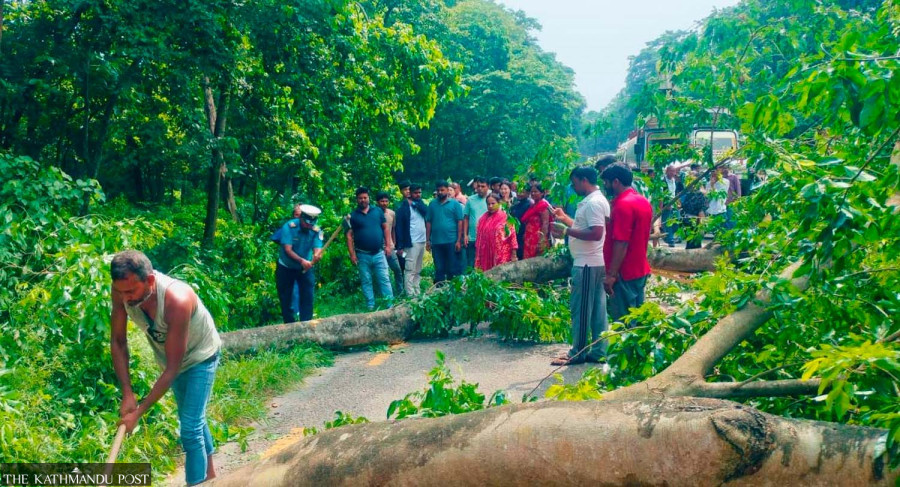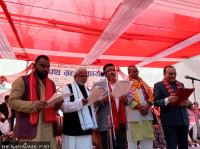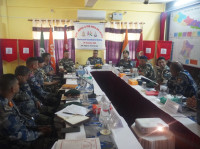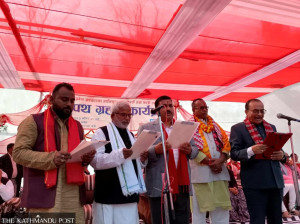Madhesh Province
Highway trees turning into deadly traps for travellers
Authorities admit the dangers along the East West Highway and have begun identifying risky trees, but funds and red tape are hindering swift removal.
Shiva Puri
As even moderately strong winds sweep across the Tarai, hundreds of trees along the East-West Highway have become looming threats. Bent and weakened by years of exposure and recent storms, many trees now hover dangerously close to the road—ready to collapse at any time without warning.
On July 17, a sal tree fell on the road along the Chandranigahapur-Bagmati section of the highway. Though no one was injured, traffic was paralysed for over an hour and a half. “Had the tree fallen just a few seconds later, it would have crushed a vehicle,” said Amar Shrestha, a bakery owner who was driving to Chandranigahapur from Bardibas. “These trees are like ambushes waiting to strike. The government must act before it’s too late,” he demanded.
Shrestha had narrowly escaped the fallen tree, which crashed just ahead of the truck he was about to overtake. “Luckily, I averted the tragedy mainly due to the loaded trucks in front of me,” said Shrestha. He’s not alone in his concerns. “Every rainy season, we drive in fear. We keep looking up, hoping nothing falls,” said Ram Kumar Mishra, a bus driver on the Birgunj-Janakpur route.
In recent times, old and big trees lining both sides of the Pathalaiya-Bardibas section of the East-West Highway have tilted dangerously, turning into potential hazards. Nearly a thousand such trees can be seen along the highway, with overhanging branches that urgently need to be managed. Drivers say they must remain hyper-alert, watching the skies as much as the road. The situation worsens in stormy weather when brittle branches break off, and in the rainy season, when such trees are uprooted.
The fear is well-founded. In recent years, several people have been injured—and some killed—by falling trees or branches. In May 2008, Dr Gyanendra Bin of Chandranigahapur Hospital died on the spot when his motorcycle struck a tree downed by a storm.
Despite recurring incidents, the authorities concerned have failed to take swift action to manage the perilous roadside trees. “In just the past month, trees collapsed three times on the highway,” said Deputy Superintendent of Police Wakil Singh, spokesperson for the Pathlaiya Highway Traffic Office. “Each time, traffic was disrupted for hours.” On July 17, a tree fell near Chandi Bridge and again on July 25, one fell on the Chandranigahapur-Bagmati stretch, halting vehicles for nearly 90 minutes.
Singh urged, “We’ve requested road and forest officials to proactively manage hazardous trees. Timely removal can prevent disaster.”
Local driver Bikki Thapa recalled his own narrow escape in 2022. “A sal tree fell just ahead during strong winds. A branch hit my hand, and I was lucky to walk away with minor injuries,” he said.
Authorities admit the problem but cite procedural delays. “We’ve started identifying risky trees and are coordinating with the forest office to remove them,” said Arun Kumar Lal Karna, chief of the Road Division Office in Chandranigahapur. “We only proceed with cutting after receiving formal approval from the Forest Department.”
But forest officials point to budget constraints. “We’ve apprised the higher authorities about the risks caused by the roadside trees,” said Hemant Sah, chief of the Division Forest Office in Chandranigahapur. “Without funding, we can’t take action, even if we want to,” he said.
The lack of coordination has real consequences. On July 5, a sudden storm toppled several trees near Dhansar. Security personnel had to work through the night to clear them with axes and saws. “These aren’t rare events,” said Lal Babu Giri, president of the Rautahat Bus Operators' Association. “Every year we face this—and every year we’re told it’s being handled.”
Giri stressed the need for urgency. “Drivers focus on the road. They can’t dodge falling trees. It’s time the Department of Roads removes this threat permanently. Travel on our national highway must be safe,” said Giri.
The East-West Highway—also known as Mahendra Highway—spans nearly 1,028 kilometres, connecting Kakadbhitta in Jhapa in the east to Gaddachauki of Kanchanpur in the west. Over 10,000 vehicles use it daily. Its role as the country’s commercial lifeline makes safety non-negotiable, say transport stakeholders.
Inaugurated in 1965 by King Mahendra, the highway revolutionised trade and mobility across Nepal. But today, overgrowth and official neglect threaten its legacy. “These trees need pruning, if not removal,” said driver Mishra. “Why must we risk our lives for nature that’s been left unmanaged?”
While local authorities promise improvements—especially with the upcoming four-lane widening—many remain skeptical. Until then, travelers along the highway must continue watching not just the traffic, but the treetops too.




 13.12°C Kathmandu
13.12°C Kathmandu













